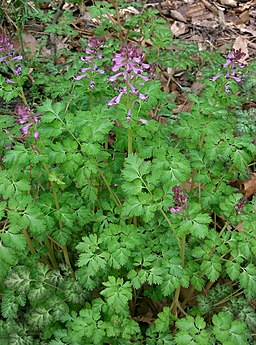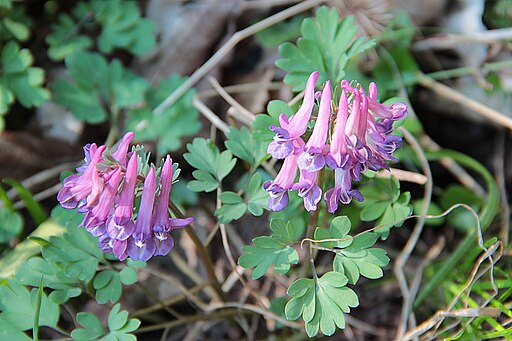Christmas berry (Photinia villosa syn. Pourthiaea villosa)
As the spring season reaches its prime and many plants begin to re-emerge, one plant to watch out for is christmas berry (Photinia villosa). Native to temperate Asia, this species was introduced to the US as an ornamental plant that is valued for its year-round beauty. However, christmas berry poses a significant ecological threat by creating dense shade and thickets that prevent native seeds from germinating and growing.
Birds are attracted to its fruits and play a role in spreading the seeds throughout native forest edges, riparian corridors, and roadsides (Lower Hudson PRISM, 2023). It’s also noted to not cut or mow christmas berry because the roots will react and increase the plant’s density. If a small plant is found in your yard, make sure to pull out all of its roots.

A dense thicket of christmas berry growing along the right side of a trail, Katja Schulz (CC BY), iNaturalist
Identifying Christmas berry
Christmas berry is a multi-stemmed shrub found near native forest edges and floodplains when it escapes cultivation. The leaves are simple, obovate to oblong-obovate with serrated margins, and arranged alternately along the stem. The upper leaf surface is bright green and pale green with fine hairs on the underside. When young, the leaves are fuzzy with hairs, which diminishes as they mature, persisting only along the veins on the underside of the leaf. The young stems of christmas berry are reddish-brown to dark brown, maturing to gray with distinct orange lenticels. Buds along the stem are brownish and less than ¼ inch long. In May, creamy, white, 5-petaled flowers with green stamens appear in flat-topped clusters of 10-20+ at the end of the branches (Flora of China, n.d.). Bunches of red, oval fruits, resembling small cherries, appear in late summer and persist through the winter. Each fruit contains 1-5 seeds. In the fall, the leaves of christmas berry display vibrant hues ranging from yellow to red.

Fall leaves with ripe fruit, Patricia Butter (CC BY-NC), iNaturalist
Native Look-a-Likes
Christmas berry looks similar the native red chokeberry (Aronia arbutifolia), which can make identification difficult, particularly in the fall when only leaves and fruits are present. Both plants have obovate to oblong-obovate serrated leaves, that are bright green and finely pubescent (hairy) along the underside vein.

Native look-alike: Red chokeberry, Andrey Zharkikh (CC BY 2.0)
The flowers of both species are 5-petaled, white and presented as clusters at the end of stems, which develop into red fruit that persist through winter (North Carolina State University Extension, n.d.).
The differences between christmas berry and red chokeberry are subtle but significant. Red chokeberry grows in a wider variety of habitats from mesic to wet soils and has a ‘neater’ vase-like growth form, versus the dense, shrubby form of christmas berry. Red chokeberry leaves emerge in the summer and are elliptic with bright purple hairs along the midvein of the leaf’s upper surface. In contrast, leaves of christmas berry are obovate in shape lack the characteristic purple hairs, instead having a white pubescence on underside of the leaf. Buds on red chokeberry are approx. ½ inch long and red, while its flowers are white with pink hues that showcase bright red to pink stamens in April. In contrast, christmas berry buds are much smaller at ¼ inch and flowering occurs later, from May to early June with the flowers producing green stamens. Red chokeberry flowers develop into red clusters of fruits that are round compared to the yellow-ish or red oval fruits of christmas berry. Similar to christmas berry, red chokeberry also has gray bark; however, it lacks the characteristic orange lenticels and instead has dark, diamond-shaped fissures as it matures.


A. Christmas berry leaves B. Lower surface of leaf



C. Red chokeberry leaves D. Lower surface of native leaves E. Purple hairs along midvein


F. Mature christmas berry bark G. Young christmas berry bark with orange spots


H. Mature chokeberry bark with widened fissures I. Young chokeberry bark with diamond-shaped fissures.


J. Christmas berry bud K. Red chokeberry bud


L. Christmas berry flowers M. Red chokeberry flowers


N. Christmas berry fruits O. Red chokberry fruits
Photo Credits: A. kellycarrot (CC BY-NC); B. josh_rudder (CC BY-NC); C. Ken Kneidel; D. & E. Dwayne Estes (CC BY-NC), iNaturalist; F. Bradley Simpson; G. sus_scrofa (CC BY), iNaturalist; H. Bradley Simpson; I. Yvonne Ng; J. & K.Bradley Simpson; L. tosakah(CC BY-NC; M. Scott A. Davis (CC BY), N. Uri Sarig (CC BY-NC); O. Laura Clark (CC BY), iNaturalist.
Tips for making a good observation on iNaturalist
Note: The scientific name for Christmas berry on iNaturalist is Pourthiaea villosa.
Take photographs that show:
-The landscape around the plant – this shows the habitat
-If they are flowering, photograph a whole plant including flowers and leaves
-If not flowering yet, photograph both surfaces of a whole, typical, undamaged leaf. With christmas berry, you should be able to see fruits during late summer
Make comments that:
-Are explicit about the issue of cultivated plant vs weed
-Provide the location or landmark, or which direction from a trail or path
-Give a rough estimate of the number of plants and the area covered any other comments you think might be helpful























































